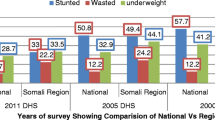Summary
Background
Malnutrition of children is a major public health problem in many African countries. Despite a relatively favourable geographical situation, the prevalence of malnutrition is high in the Sikasso region (Mali).
Methods
Survey repeated annually during 5 years, to a sample of 491 families living in Sikasso. The determinants of wasting and stunting were analysed using logistic regression.
Results
The prevalence of stunting was about 25%. Prevalence of wasting was about 12%, which is very high, and had been increasing in the past years. No strong associations with socio-economic factors were observed for wasting. Stunting was strongly associated with the education level of both parents, and with the family assets.
Zusammenfassung
Situation
Der schlechte Ernährungszustand von Kindern in vielen afrikanischen Ländern ist eines der wesentlichen Gesundheitsproblemen. Dies ist auch in Sikasso (Mali) der Fall, obwohl diese Region geographisch günstig situiert ist.
Methode
Diese Artikel schildert eine Erhebung, in welcher wahrend fünf Jahren jährlich der Ernährungszustand von 491 Familien erfasst worden ist. Die Determinanten des Ernährungszustandes der Kinder dieser Familien wurden mittels logistischer Regressionanalyse erhoben.
Resultate
Es zeigte sich, dass die Prävalenz der chronischen Ernährungsprobleme um die 25% liegt. Eine Assoziation von Ausbildungsgrad der Eltern und ökonomischem Stätus der Familien liess sich nachweisen. Die Prävalenz akuter Ernährungsprobleme liegt um die 12%, was sehrhoch ist, letztere nahm über die Jahrezu; es bestand keine Korrelation zu sozio-ökonomischen Faktoren.
Résumé
Situation
La malnutrition des enfants est un problème majeur de santé publique dans de nombreux pays africains. Malgré une situation géographique relativement favorable, la prévalence de la malnutrition est élevée dans la région de Sikasso (Mali).
Méthode
Enquête annuelle répétée au cours d'une période de 5 ans, sur un échantillon de 491 familles. Les déterminants de la malnutrition sont analysés par régression logistique.
Résultats
La prévalence de la malnutrition chronique se situe autour de 25%, tandis que celle de la malnutrition aigué autour de 12%. Ce dernier pourcentage est très élevé et a augmenté au cours des dernieres années. Aucune association importante n'a été observée avec les facteurs socio-économiques en ce qui concerne la malnutrition aiguë. Au contraire, la malnutrition chronique est fórtement associée avec le niveau d'éducation des parents, ainsi qu avec l'aisance materielle de la famille.
Similar content being viewed by others
References
Pinstrup-Andersen P, Burger S, Habicht JP, Peterson K. Protein-energy malnutrition. In: Jamison DT, Mosley WH, Measham AR, Bobadilla JL. Disease control priorities in developing countries. Washington: The World Bank; Oxford University Press, 1993: ch. 18.
Traoré B, Konaté M, Stanton C. Enquête démographique et de santé au Mali, 1987. Bamako: CERPOD, 1989.
United States, Public Health Service, Health Resources Administration. NCHS Growth charts, Rockville, MD, 1976 (HRA 76-1120, 25, 3).
ANTHRO, VERSION 1.01. Division of Nutrition, Centers for Disease Control, in collaboration with the Nutrition Unit, World Health Organisation, 1990.
Waterlow JC. Classification and definition of protein-calorie malnutrition. Br Med J 1972;3:566–569.
WHO Working Group. Use and interpretation of anthropometric indicators of nutritional status. Bull World Health Organ 1986;64: 929–941.
Clayton DC, Hills M. Statistical methods in epidemiology. Oxford: Oxford University Press, 1993.
Victora CG. The association between wasting and stunting: An international perspective. Washington: American Institute of Nutrition, 1991.
Ashworth A, Dowler E. Child malnutrition. Chap 8 in: Feachem RG, Jamison DT, eds. Disease and mortality in sub-Saharan Africa. Washington: The World Bank, Oxford University Press, 1991: ch. 8.
Keller W, Fillmore CM. Prevalence of protein-energy malnutrition. World Health Stat Q 1983;36: 129–167.
Soysa PE, Waterlow JC. Stunting and the prevalence of malnutrition. Lancet 1981;1:1430.
Victora CG, Vaughan JP, Kirkwood BR, Martines JC, Barcelos LB. Risk factors for malnutrition in Brazilian children: the role of social and environmental variables. Bull World Health Organ 1986;64:299–309.
Hobcraft J, McDonald J, Rutstein SO. Socio-economic factors in infant and child mortality: A cross-national comparison. Popul Stud 1984;38:193–223.
Richardson SA. The background histories of school children severely malnourished in infancy. Adv Pediatr 1974;21:167–195.
Tomkins AM, Drasar BS, Bradley AK, Williamson WA. Water supply and nutritional status in rural northern Nigeria. Trans R Soc Trop Med Hyg 1978,72:239–243.
Gorstein J. Assessment of nutritional status: effects of different methods to determine age on the classification of undernutrition. Bull World Health Organ 1989;67:143–150.
Author information
Authors and Affiliations
Rights and permissions
About this article
Cite this article
Bouvier, P., Papart, JP., Wanner, P. et al. Malnutrition of children in Sikasso (Mali): prevalence and socio-economic determinants. Soz Präventivmed 40, 27–34 (1995). https://doi.org/10.1007/BF01615659
Issue Date:
DOI: https://doi.org/10.1007/BF01615659



